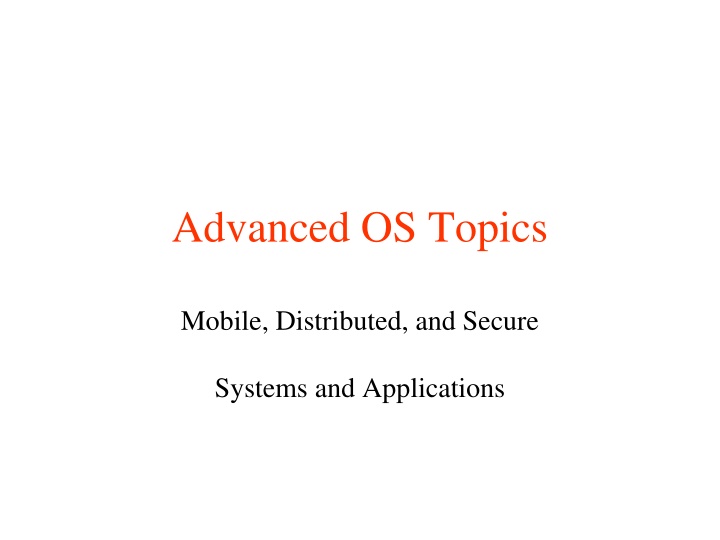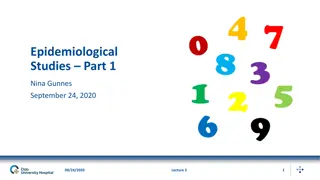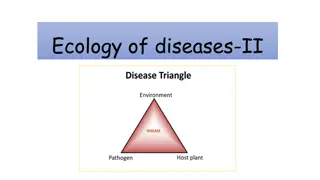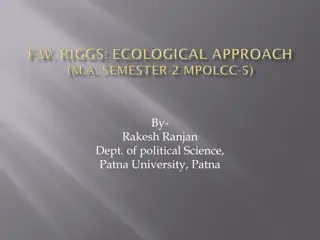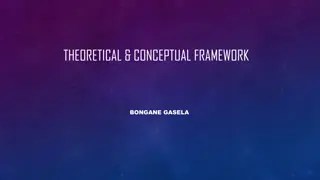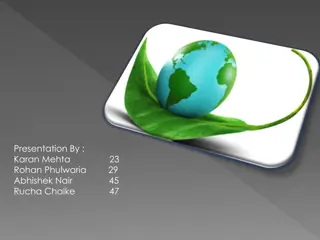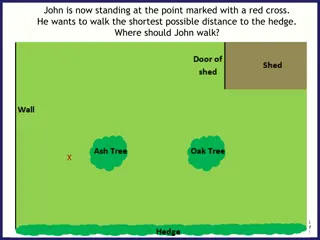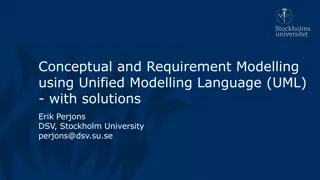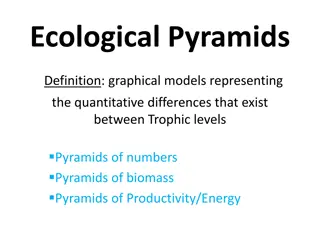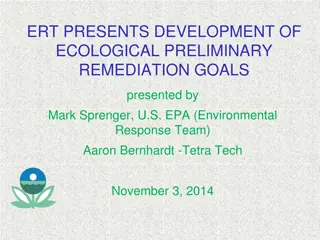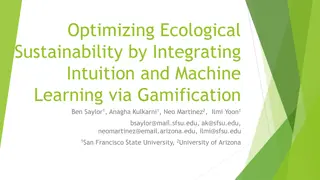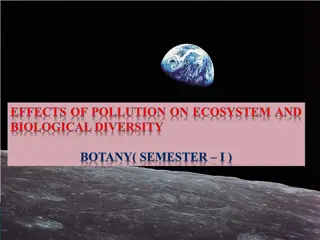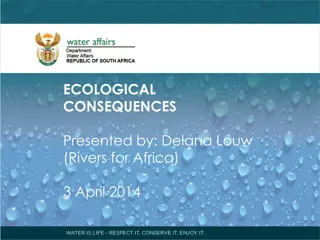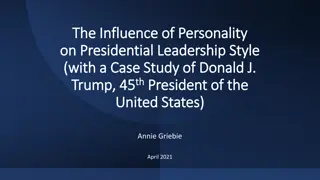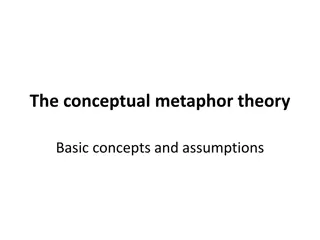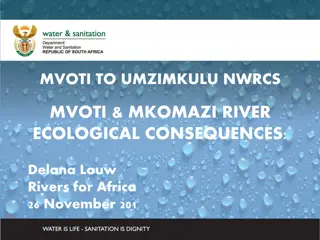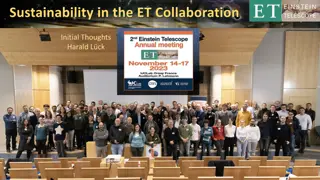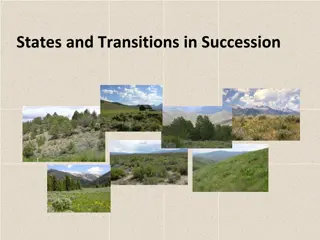Co-constructing Conceptual Models for Ecological Dynamics
Dive into the co-construction of conceptual models focusing on ecological dynamics, problem actors, resources, interactions, and more. Explore the interconnectedness of ecological elements, human-driven and nature-driven factors, and the dynamics shaping landscapes. Gain insight into the processes influencing transitions in land use and cover, with a practical example from Camargue.
Download Presentation

Please find below an Image/Link to download the presentation.
The content on the website is provided AS IS for your information and personal use only. It may not be sold, licensed, or shared on other websites without obtaining consent from the author.If you encounter any issues during the download, it is possible that the publisher has removed the file from their server.
You are allowed to download the files provided on this website for personal or commercial use, subject to the condition that they are used lawfully. All files are the property of their respective owners.
The content on the website is provided AS IS for your information and personal use only. It may not be sold, licensed, or shared on other websites without obtaining consent from the author.
E N D
Presentation Transcript
Advanced OS Topics Mobile, Distributed, and Secure Systems and Applications
The insiders view of a Centralized OS The insider s view of a centralized OS. (Roughly patterned after XINU [Comer 1984]) user programs file system 1 device manager and device drivers real-time clock manager 2 process coordinator process manager memory manager 3 hardware 1 remote files 2 + remote device access 3 + remote process management
Natural Extensions Two Trends System Virtualization Allow multiple instances of (possibly different) OSes on a single machine Distributed OS Large scale networked systems/machines Emerging Distributed Apps Blockchain and Smart Contract, BitCoin, Ethereum, Lighting Networks, Stella, etc. P2P file sharing, Hadoop & Spark Data outsourcing: Google Docs, Data centers. Streaming, IPTV/VoIP Web-based services and OS Wikipedia, etc.
Virtualization After Virtualization Before Virtualization Idea: Decouple [OS, service] pair from hardware Multiplex lightly-used services on common host hardware Migrate services from host to host as needed Introduce new [OS, service] pairs as needed
Distributed Systems and Applications
Bitcoin Open source P2P Money http://bitcoin.org/en/
Hadoop and Spark http://hadoop.apache.org/ https://spark.apache.org/
Google Office Google Docs & Spreadsheets mimic functions of Microsoft Office tools on the Web Free storage, linked with Gmail Work and collaborate as long as you have access to a Web browser Uniform look and feel on all OS platforms Ajax and other software techniques make it as responsive as local applications network latencies are hidden The future of computing? Web browser + open source, or Google + Linux? No need to buy computers and software Who will pay for Windows and Office in the future?
Multicast and Multimedia The key application was streaming audio/video Webinar Stock Information On-line TV/Video Group-based Apps (game, )
Electronic Health Care Systems Monitoring a person in a pervasive electronic health care system, using (a) a local hub or (b) a continuous wireless connection
Peer-to-Peer and Blockchain A killer application: Naptser Free music over the Internet Key idea: share the content, storage and bandwidth of individual (home) users Exemplar P2Ps: Naptser, Gnutella, Freenet, CAN, Chord, BitTorrent Internet
Web 2.0: Wikipedia Wikipedia is a multilingual, Web-based, free content encyclopedia project. It is written collaboratively by volunteers, allowing most of its articles to be edited by almost anyone with access to the Web site. The largest collaborative authoring (group editing) project in the world
Security SSL Handshake Protocol Cipher suite: a list of cryptographic algorithm supported by the client Phase 1: Establish security capabilities Establish protocol version, session ID, cipher suite, compression method, exchange random values ClientHello ServerHello Phase 2: Sever authentication and key exchange Certificate Optionally send server certificate and request client certificate Certificate Request ServerHelloDone Phase 3: Client authentication and key exchange Send client certificate response if requested Client Certificate Server Certificate Verify Phase 4: Finish Change Cipher Spec Change cipher suite and finish handshake The client sends a change Cipher Spec message and copies the pending CipherSpec into the current CipherSpec. Finished Change Cipher Spec Finished
The ANDROID OS History Google acquires mobile software startup Android 2005 Open Handset Alliance officially starts on November 5th, 2007 Android 1.0 source and SDK released in Fall 2008 (http://www.android.com/timeline.html) Now Android 10 in Phones & Tablets Toshiba Android SmartBook Sony Ericsson Cisco Android Tablet Samsung Galaxy
The ANDROID OS System Architecture Linux Davlik-VM/ART Application Framework
The ANDROID OS Applications Applications are written in Java or Python Applications are run on the Davlik VM, and now ART Development done in the Android Development is open to all User driven Android SDK Market
ANDROID Security Android Security Relies on security of it s foundations; Linux, Davlik/ART, and Java. Security Goal: A central design point of the Android security architecture is that no application, by default, has permission to perform any operations that would adversely impact other applications, the operating system, or the user.
ANDROID Security Enforcement strategy Verified Boot Application signing and certification. Linux user name base access restriction Permissions Application Sandboxes All Applications run as their own Linux user. Inter-Process Communication methods: Activities Services BroadcastReceiver ContentProvider Intent
ANDROID Security Android Permissions are static on install Users have open view of permissions Permissions http://developer.android.com/reference/android/Manifest.permission.html http://www.simplehelp.net/images/quick_gps/img06.png
ANDROID Security Security Concerns for developers Protect your application, use least privilege principle. If you expose, mediate IPCs Provide maximum availability Minimize memory footprint Minimize battery usage Security Concerns for users Do your research Read reviews. Analyze permissions before installing. Use Common sense.
CprE 536: Computer and Network Forensics (Fall) CprE 450/550: Distributed Systems and Middleware (Spring) CprE 4xx/5xx: Operating System Security (Spring, New) You are welcome to join me!
